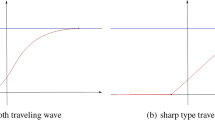Abstract
We consider a system of two reaction-diffusion equations in a bounded domain of the \( m \)-dimensional space with Neumann boundary conditions on the boundary for which the reaction terms \( f(u,v) \) and \( g(u,v) \) depend on two parameters \( a \) and \( b \). Assume that the system has a spatially homogeneous solution \( (u_{0},v_{0}) \), with \( f_{u}(u_{0},v_{0})>0 \) and \( -g_{v}(u_{0},v_{0})=F(\operatorname{Det}(\operatorname{J})) \), where \( \operatorname{J} \) is the Jacobian of the corresponding linearized system in the diffusionless approximation and \( F \) is a smooth monotonically increasing function. We propose some method for the analytical description of the domain of necessary and sufficient conditions of Turing instability on the plane of system parameters for a fixed diffusion coefficient \( d \). Also, we show that the domain of necessary conditions of Turing instability on the plane \( (\operatorname{Det}(\operatorname{J}),f_{u}) \) is bounded by the zero-trace curve, the discriminant curve, and the locus of points \( \operatorname{Det(\operatorname{J})}=0 \). Explicit expressions are found for the curves of sufficient conditions and we prove that the discriminant curve is the envelope of the family of these curves. It is shown that one of the boundaries of the Turing instability domain consists of the fragments of the curves of sufficient conditions and is expressed in terms of the function \( F \) and the eigenvalues of the Laplace operator in the domain under consideration. We find the points of intersection of the curves of sufficient conditions and show that their abscissas do not depend on the form of \( F \) and are expressed in terms of the diffusion coefficient and the eigenvalues of the Laplace operator. In the special case \( F(\operatorname{Det}(\operatorname{J}))=\operatorname{Det}(\operatorname{J}) \). For this case, the range of wave numbers at which Turing instability occurs is indicated. We obtain some partition of the semiaxis \( d>1 \) into half-intervals each of which corresponds to its own minimum critical wave number. The points of intersection of the curves of sufficient conditions lie on straight lines independent of the diffusion coefficient \( d \). By way of applications of the statements proven, we consider the Schnakenberg system and the Brusselator equations.
Similar content being viewed by others
References
Murray J.D., Mathematical Biology II: Spatial Models and Biomedical Applications, Springer, New York (2003).
Li P., Shi J., Wang Y., and Feng X., “Bifurcation analysis of reaction-diffusion Schnakenberg model,” J. Math. Chemistry, vol. 51, no. 8, 2001–2019 (2013).
Jiang W., Wang H., and Cao X., “Turing instability and Turing–Hopf bifurcation in diffusive Schnakenberg systems with gene expression time delay,” J. Dyn. Differ. Equ., vol. 31, no. 4, 2223–2247 (2019).
Revina S.V. and Lysenko S.A., “Sufficient Turing instability conditions for the Schnakenberg system,” Vestnik Udmurtskogo Universiteta. Matematika. Mekhanika. Komp’yuternye Nauki, vol. 31, no. 3, 424–442 (2021).
Funding
This work was supported by ongoing institutional funding. No additional grants to carry out or direct this particular research were obtained.
Author information
Authors and Affiliations
Corresponding author
Ethics declarations
As author of this work, I declare that I have no conflicts of interest.
Additional information
Translated from Vladikavkazskii Matematicheskii Zhurnal, 2022, Vol. 24, No. 4, pp. 117–126. https://doi.org/10.46698/d6373-9335-7338-n
Publisher's Note
Pleiades Publishing remains neutral with regard to jurisdictional claims in published maps and institutional affiliations.
Rights and permissions
About this article
Cite this article
Revina, S.V. Diffusion Instability Domains for Systems of Parabolic Equations. Sib Math J 65, 487–494 (2024). https://doi.org/10.1134/S0037446624020216
Received:
Accepted:
Published:
Issue Date:
DOI: https://doi.org/10.1134/S0037446624020216




